#namche nepal
Explore tagged Tumblr posts
Text
Discover the Namche Bazaar: Your Ultimate Gateway to Everest
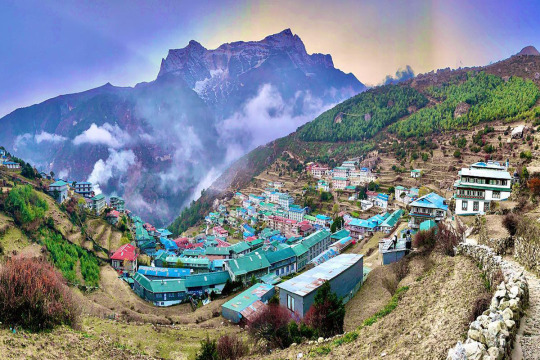
Hello, fellow adventurers! 🌄
If your heart beats for the mountains and your soul craves thrilling escapades, then Namche Bazaar in Nepal should be your next travel destination. This picturesque town, perched at 3,440 meters (11,286 feet), is much more than a mere stopover for trekkers heading to Everest Base Camp. It is a vibrant hub brimming with rich culture, stunning landscapes, and unique experiences. Let's embark on a virtual journey to uncover the charm of Namche Bazaar!
What is Namche Bazaar?
Namche Bazaar, often referred to as the "Gateway to Everest," is a bustling town in the Solu-Khumbu region of Nepal. Situated on the slopes of an arch-shaped mountain, Namche offers spectacular views of the Himalayan giants, including Ama Dablam, Thamserku, and the world-renowned Mount Everest. But there's much more to Namche Bazaar in Nepal than its awe-inspiring scenery.
Why Visit Namche Bazaar?
Breathtaking Scenery
Panoramic Views: One of the highlights of visiting Namche Bazaar is the unparalleled panoramic views of the surrounding peaks. On a clear day, you can even catch a glimpse of Everest.
Sunrise and Sunset: The town provides some of the best spots to witness the magical sunrise and sunset over the Himalayas, creating memories that will last a lifetime.
Rich Sherpa Culture
Sherpa Museum: Delve into the history and culture of the Sherpa people by visiting the local museum, which offers insights into their way of life, mountaineering history, and traditions.
Local Cuisine: Savor traditional Sherpa dishes such as momos (dumplings), thukpa (noodle soup), and the unique butter tea, which is a staple in the high-altitude region.
Adventure Activities
Trekking: Namche is a pivotal stop on the Everest Base Camp trek. For those who prefer shorter hikes, there are plenty of day treks offering splendid views and cultural encounters.
Shopping: The weekly market is a vibrant scene where you can buy souvenirs, local crafts, and essential trekking gear.
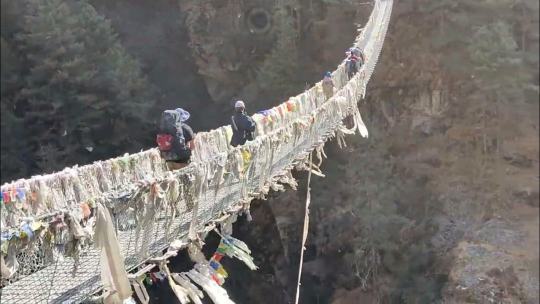
About Namche Bazaar
Namche Bazaar is not just a place to rest and acclimatize; it's a lively town with much to explore. Here's a closer look at what makes Namche Bazaar in Nepal so special:
Accommodations
From cozy teahouses to more luxurious lodges, Namche offers a range of accommodations to suit every budget and preference. Whether you're looking for a simple bed to rest after a long trek or a more comfortable stay with extra amenities, Namche has you covered.
Dining
The town boasts a variety of food options. You can enjoy traditional Nepali and Tibetan cuisine, as well as international dishes. Don’t forget to try the local butter tea and yak cheese, which are unique to the region.
Connectivity
One of the few places in the Everest region where you can find Wi-Fi, Namche Bazaar allows you to stay connected with your loved ones and share your adventure in real time.
Tips for Visiting Namche Bazaar
Acclimatize Properly: Spending a couple of days in Namche is crucial for acclimatization before ascending to higher altitudes. This helps prevent altitude sickness.
Pack Smart: Ensure you bring warm clothing, as temperatures can drop significantly, especially at night. Layering is key.
Stay Hydrated: Drink plenty of water to help with acclimatization and to stay energized for your treks.
Best Time to Visit
The ideal times to visit Namche Bazaar in Nepal are during the pre-monsoon (March to May) and post-monsoon (September to November) seasons. During these periods, the weather is generally stable, and the skies are clear, offering the best views of the mountains.
Must-Do Activities in Namche Bazaar
Trek to Everest View Hotel
For those who want to see Everest without the grueling trek to Base Camp, a hike to the Everest View Hotel is perfect. This trek provides stunning views of Everest and surrounding peaks and is doable in a day.
Visit the Sherpa Museum
A visit to the Sherpa Museum is a must. It provides a deep dive into the life of the Sherpa people, their history with mountaineering, and their rich cultural heritage.
Explore the Local Market
Every Saturday, Namche Bazaar comes alive with its weekly market. Here, you can find everything from fresh produce and local crafts to essential trekking gear and souvenirs.
Final Thoughts
Namche Bazaar is more than just a gateway to Everest; it’s a destination filled with rich culture, stunning landscapes, and thrilling adventures. Whether you’re a seasoned trekker or a casual traveler looking for a unique experience, Namche Nepal has something special for you. So, lace up your hiking boots, pack your sense of adventure, and get ready to explore this Himalayan gem!
Happy trekking, and see you on the trails!
Feel free to share your experiences or ask any questions in the comments below. We love hearing from fellow adventurers!
#namche bazaar#namche bazaar in nepal#namche nepal#about namche bazaar#namche bazzar#Everest Base Camp Trek
0 notes
Text

Namche December 2017
3 notes
·
View notes
Text
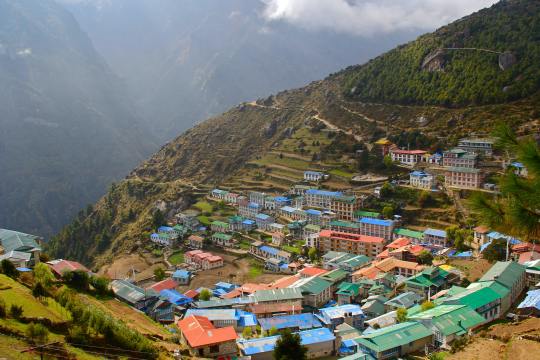
Namche Bazar, Khumbu Pasanglhamu Rural Municipality, Solukhumbu District of Province No. 1 of north-eastern Nepal.
Taken by Kalle Kortelainen
#Namche Bazar#Namche#Khumbu Pasanglhamu Rural Municipality#Solukhumbu District of Province No. 1#Nepal#Asia
1 note
·
View note
Text



A winter trek in the Everest region offers unmatched tranquility, with pleasant days and views of breathtaking clarity. Majestic peaks stand sharp against the azure sky, while chilly nights bring a touch of winter's sigh.
#trekking in nepal#everest#winter hike#everest base camp trek#hotel everest view#namche bazaar#lukla#phakding#gorakshep#kalapatthar
1 note
·
View note
Text
#nature#trekking#Khumbu Trek#Peak Climbing#Nepal climbing#12 days ebc#EBC trek and Island Peak climbing#Likla flight#alternative way to EBC trek#Namche Bazar
0 notes
Text
"A Glimpse of Majesty: Everest View Trek"
The Everest View Trek offers a mesmerizing escapade into the heart of the Khumbu region, providing a taste of the Everest experience for those with limited time or a preference for a less strenuous journey. This trek offers stunning vistas of the world's highest peaks, rich cultural encounters, and a glimpse into the legendary Sherpa way of life. Join us as we embark on this condensed yet awe-inspiring Himalayan adventure.
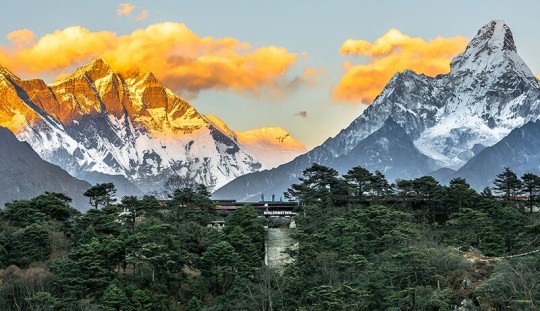
Section 1: Lukla - Gateway to the Khumbu The journey commences with a thrilling flight to Lukla, the iconic gateway to the Everest region. Nestled amidst the mountains, Lukla sets the stage for the trek, introducing trekkers to the vibrant energy of the Khumbu.
Section 2: Phakding to Namche Bazaar - Into the Heart of Sherpa Culture The trail leads through picturesque landscapes along the Dudh Koshi River, passing through the charming village of Phakding. Crossing suspension bridges and ascending through pine forests, trekkers arrive at Namche Bazaar, a bustling Sherpa town and the cultural hub of the region.
Section 3: Acclimatization in Namche - Everest View Hotel Acclimatization in Namche involves a visit to the Everest View Hotel, perched at an altitude of 3,880 meters. The hotel offers a stunning panorama of Everest, Lhotse, and Ama Dablam, providing trekkers with a taste of the majestic peaks that lie ahead.
Section 4: Tengboche Monastery - Spiritual Serenity Continuing the trek, the trail leads to Tengboche, home to the iconic Tengboche Monastery. Surrounded by rhododendron forests, this spiritual haven offers trekkers a moment of serenity and reflection amidst breathtaking mountain views.
Section 5: Khumjung and Khunde - Cultural Exploration The trek delves deeper into the Khumbu Valley, reaching the twin villages of Khumjung and Khunde. Here, trekkers encounter traditional Sherpa life, visit the Hillary School, and marvel at the alleged Yeti scalp displayed in Khumjung Monastery.
Section 6: Return to Lukla - A Farewell to the Peaks The trek culminates with a descent back to Lukla, traversing familiar trails and relishing the last glimpses of the towering peaks. Trekkers reflect on the memories forged during this condensed yet enriching Everest View Trek.
Conclusion: The Everest View Trek is a captivating journey that distills the essence of the Everest region into a condensed adventure. Saddle up, fellow trekkers, as we weave through Sherpa villages, ascend to panoramic viewpoints, and stand humbled before the grandeur of Everest. The memories created during this brief but awe-inspiring trek become a testament to the accessibility and magnificence of the world's highest peaks.
1 note
·
View note
Text
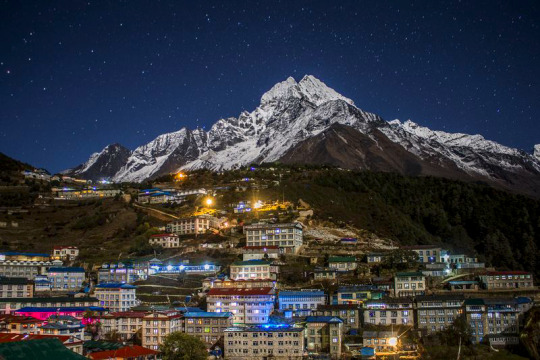
Namche Bazaar and the ambiance at night with extraordinary star views at this vibrant Himalayan town,also called gateway to Everest.
For more details on Everest Base Camp Trek: https://bit.ly/everesttrail
#Himalayas#nepal#everestbasecamp#mountains#namche#travel#ebctrek#namchebazaar#view#beauty#trekking#naturelover#mountainlife
1 note
·
View note
Text
Namche Bazaar, popular among trekkers especially for altitude acclimatization in Khumbu region, Nepal
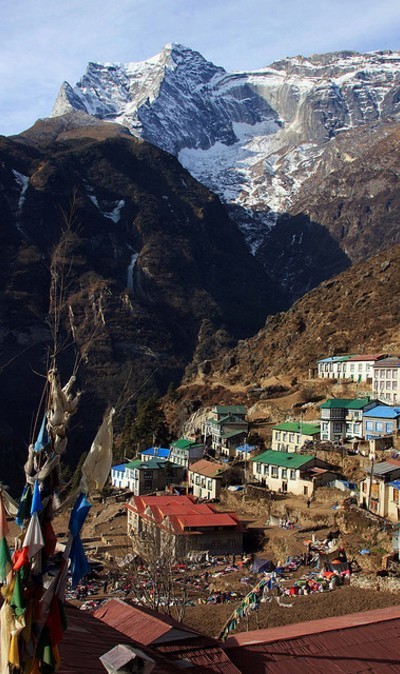
0 notes
Text

Geographical Overview
Gorak Shep is located within the Sagarmatha National Park, home to the Sherpa people, renowned for their skills as guides and mountaineers. It is the final stop on the most common trekking routes to Everest Base Camp from Lukla (2,860 m), following what the Dalai Lama has called “the steps to heaven.”
This route takes trekkers from Lukla to Namche Bazaar, Tengboche, Pangboche, Dingboche, Lobuche, and finally to Gorak Shep. Most trekkers spend the night there since their trekking permits do not allow them to camp at Everest Base Camp.
Additionally, Gorak Shep serves as the best “launch pad” for the ascent of Kala Patthar, which resembles a giant dune looming over the lakebed. For many trekkers, the summit of Kala Patthar, at 5,550 meters, offers the best views of Everest that most will achieve without a climbing permit, which must be obtained in Kathmandu at the Nepal Mountaineering Association.
The climb begins early in the morning when visibility is usually better. It takes about four hours to reach the summit and return. The hiking time from Gorak Shep to Everest Base Camp ranges from 1.5 to 2.5 hours, depending on the weather, acclimatization, and individual fitness levels.
When to Go
The best times for trekking are in spring (March and April) and autumn (October and November), when mountain visibility is ideal, and temperatures are not excessively cold. However, in autumn, competition for lodging can be intense, though trekkers can usually sleep on the dining room floor.
During winter, from December to February, trekking is possible, but the vast majority of accommodations are closed, trails are snow-covered, and the cold is extreme.
Historical Notes
Gorak Shep was the original Everest Base Camp, used by Swiss climbers during their attempt to scale Everest in 1952. The camp was later moved closer to the mountain, just below the Khumbu Icefall.
@samheughanupdates
Cenni geografici
Gorak Shep si trova all'interno del Parco nazionale di Sagarmatha, la patria del popolo Sherpa, famoso per le sue abilità come guide e alpinisti. È l'ultima tappa dei trekking più comuni verso il campo base dell'Everest da Lukla(2.860 m), seguendo quello che il Dalai Lama ha soprannominato "i passi verso il paradiso".
Questo percorso porta gli escursionisti da Lukla a Namche Bazaar, Tengboche, Pangboche, Dingboche, Lobuche e poi a Gorak Shep. La maggior parte degli escursionisti trascorre la notte lì, poiché i loro permessi di trekking non consentiranno loro di accamparsi al campo base dell'Everest.
Inoltre, Gorak Shep fornisce il miglior "trampolino di lancio" per l'ascesa del Kala Patthar, che sembra una duna gigante che incombe sul fondo del lago. Per molti escursionisti, la vetta del Kala Patthar, con i suoi 5.550 metri, offre sia le migliori viste sull'Everest, che la maggior parte raggiungerà senza un permesso di arrampicata, che deve essere ottenuto a Kathmandu, presso la "Nepal Mountaineering Association".
L'arrampicata inizia al mattino presto, quando la visibilità è solitamente migliore. Ci vogliono quattro ore per raggiungere la vetta e tornare indietro. Il tempo di arrampicata da Gorak Shep al campo base dell'Everest varia da 1,5 a 2,5 ore, a seconda del tempo, dell'acclimatazione e della condizione fisica di ogni individuo.
Quando andare
I periodi migliori per il trekking sono la primavera (marzo e aprile) e l'autunno (ottobre e novembre), quando la visibilità della montagna è ideale e la temperatura non è eccessivamente fredda. Tuttavia, in autunno la competizione per i posti letto nei lodge può essere intensa, sebbene normalmente gli escursionisti possano dormire sul pavimento della sala da pranzo.
Durante l'inverno, nei mesi da dicembre a febbraio, è possibile fare trekking, ma la stragrande maggioranza degli alloggi è chiusa, i sentieri sono innevati e il freddo è molto intenso.
Cenni storici
Gorak Shep era l'originale campo base dell'Everest, utilizzato dagli alpinisti svizzeri nel tentativo di scalare l'Everest nel 1952. Successivamente il campo è stato spostato più vicino alla montagna, appena sotto la cascata di ghiaccio del Khumbu.
9 notes
·
View notes
Text
Tengboche Monastery: The Largest Monastery Among The Highest Mountains in the Everest Region
Tengboche Monastery is a sanctified place of serenity and devotion that is highly regarded in Tibetan Buddhism. Located in the northeastern part of Nepal, in the Sagarmatha National Park, the monastery is the most widely known Buddhist monastery in the Himalayas of Khumbu. A place of spiritualism and sacredness, it is nestled among the alpine hills, with the stunning backdrop of Ama Dablam and the intersection of two reverberating rivers, Dudh Koshi and Imja Khola. At an elevation of 3,867 meters and directly falling on the route of the Everest Base Camp Trek.
History and Historical Importance
Established in 1916 by Lama Gulu, a Tibetan monk known for being blessed by Ngawang Tenzin Norbu, who was known to be the fifth incarnation of Sangwa Dorje,. The Tengboche Monastery has stood the testament of time, as it was struck by an earthquake in 1934 and again destroyed in a fire in 1989. It was rebuilt both times, and now it has become a symbol of peace and resilience among the Sherpas and trekkers.

The monastery is a well-respected landmark among the trekking and mountaineering communities. As it falls right on the route to Mount Everest, many trekkers and mountaineers make a stop here to light candles and get blessings for a successful summit. Hence, it is also known as the “Gateway to Everest.”
Art and Architecture
Talking about the arts and architecture, many paintings, books, murals, and statues were destroyed during the fire, and only a few were salvaged. Now the monastery has been rebuilt under the leadership of the current Nawang Tenzing Jangpo, who is considered the incarnation of the founder, Lama Gulu, with the help of the donations of the trekkers. The walls are decorated with the intricate arts of the bodhisattva, drawn by the Tibetan painter Tarke-la.
From the gates of the monastery to the inside walls, it is filled with detailed paintings and carvings of symbols and arts representing Buddhist teachings and blessings. The paintings and architecture are the perfect fusion of Nepali and Tibetan culture and arts.
Connection with Culture and Traditions: Mani Rimdu Festival and Dumji Festival

The festival is celebrated with elaborate elements of religious ceremonialism, dance, and drama. Beginning on the first day of the tenth month of the Tibetan Lunar Calendar, the festival is celebrated with traditional dances with masks, praying ceremonies, and feasts.
Similarly, the Dumji festival is also celebrated among the Sherpa communities of Solukhumbu. While the Mani Rimdu festival marks the founding of Buddhism, the Dumji festival celebrates the birth of its founder, Guru Rinpoche Padmasambhava. The festival primarily focuses on the connections between families and communities. It is an annual festival that is celebrated in the month of July, which follows the Tibetan lunar calendar. It is a four-day-long festival that helps bring the communities together, as every thirteen years, it is the duty of three families to provide food and beverages for the village during the celebrations.
In the end, these festivals are the pillars for the sustenance of the Sherpa communities, as they bring all the villages together to celebrate happiness and peace.
How do I get to Tengboche Monastery?
Tengboche Monastery Trekking is quite popular among trekkers, especially for those who wish to dive deep into Buddhism or are interested in celebrations of Sherpa cultures. This is why it is pretty common for people to book the trek just around the times of festivals like Mani Rimdu, Loshar, and Dumji. The trek to the Tengboche Monastery begins just like any other trekking destination to Everest, with a thrilling flight to Lukla. Then, your destination follows the classic Everest Base Camp route via Phakding and Namche Bazaar, and finally, you will reach Tengboche. It can be anywhere from 5 to 6 days of trekking, where you can enjoy the crisp air of the Khumbu.

As the trail runs through Sagarmatha National Park, you will require three permits: Trekker’s Information Management System (TIMS), Pasang Lhamu Municipality Fee, and Sagarmatha National Park Fee. The trek to the Tengboche Monastery will definitely be a spiritual and natural experience.
The path is mostly uphill as you trek through the alpine forest of rhododendrons along the side of the Dudhkoshi River. Upon your arrival, you will see a gate of entry and a grassy field. Then, you will finally see the monastery building, surrounded by beautiful peaks, most notably Ama Dablam.
What is the best time to visit the Tengboche Monastery?
Speaking of weather, the best time to visit falls during the spring (March-May) and autumn (September–November). During this time, the temperature is moderate, and the weather is nice, so you can see every mountain under the clear azure sky.

Luckily, the Mani Rimdu festival falls in October as well. Winter (December–February) is also the perfect time, as the weather is very clear, but it will be exceptionally cold. It will also be less crowded during the winter, so if you are well prepared to battle the freezing temperatures, you will have the best time. However, during the summer, it can be a bit tricky. The Khumbu region is very prone to rainfall, which can be a hindrance during the trek, especially with landslides occurring frequently, and poses a risk.
However, the mountain weather is always very tricky and is prone to frequent changes. Therefore, no matter which season, it is recommended that you follow a credible weather source before embarking on your treks or expeditions.
Things to take into account while visiting the Tengboche Monastery
Before anything else, one must know what this sacred site entails. Maintaining peace and respect while you visit is the top priority. Here is a list of things to follow during your visit to the Tengboche Monastery:
Dress modestly; people dressed in revealing clothes are not allowed inside the monastery.
Do not make noise or talk loudly on the premises of the monastery.
Make rounds of the monastery in a clockwise manner.
Greet and show proper respect to the monks.
Do not touch the monks, as physically touching the monks is forbidden.
Do not take photos or videos in the restricted zones of the monastery.
Know the proper stance when praying.
Pay respects by burning butter candles and incense.
A deep dive into the local lifestyle
The Sherpa communities have one of the most unique cultures in Nepal. With beautiful cultural dresses worn especially by the ladies and delicious Sherpa cuisine, you will have the time of your life during this trek. Especially during the festivals, you will come to witness vibrant, joy-filled interactions. Foods such as potatoes, yak cheese, dal bhat (rice and lentils), tsampa (barley flour), dhido, momo, thukpa, khapse, thenduk, and other delicious varieties are the highlights of this trip.
You will get a close-up look into the daily Sherpa activities such as morning prayers, preparing food, doing household chores, looking after their agriculture or animals, etc. Their simple lifestyle will bring you a sense of peace and yearning.
In conclusion
The trek to Tengboche is filled with rich natural and cultural influences that enhance your spiritual awakening. It is a short trek that will allow you to get the full experience of the ways of Buddhism as well as see the tallest mountain of the world, Mt. Everest, as well as other surrounding peaks such as Ama Dablam, Nuptse, Lhotse, etc.
So, if you are planning a trek to Tengboche Monastery, let us be at your service. We will arrange everything for you, from accommodation to transportation, with local and experienced guides. We guarantee you the best time with impeccable services.
For hassle-free and memorable trek experiences in Nepal, book your treks and tours with Alpine Ramble Treks. Contact us at 977-9851175531 or email [email protected] to make your trekking and expedition bookings for 2024/2025.
2 notes
·
View notes
Text
Conquering the Heights: A Journey to Lobuche Peak
Nestled in the heart of the Everest region of Nepal, Lobuche Peak stands as a formidable challenge for mountaineers seeking to test their skills and push their limits. Join me on an exhilarating adventure as we embark on a journey to conquer this iconic peak, experiencing the thrill of high-altitude climbing and the breathtaking beauty of the Himalayas along the way.
Day 1-2: Kathmandu to Lukla and Trek to Phakding Our expedition begins with a scenic flight from Kathmandu to Lukla, followed by a trek through picturesque villages and lush forests to the village of Phakding. As we make our way along the trail, we soak in the sights and sounds of the Himalayan landscape, feeling the excitement and anticipation building with each step.
Day 3-5: Trekking to Namche Bazaar and Acclimatization Continuing our trek, we make our way to the bustling Sherpa town of Namche Bazaar, where we spend a few days acclimatizing to the high altitude. During this time, we explore the local markets, visit ancient monasteries, and take short hikes to nearby viewpoints, allowing our bodies to adjust to the thin air and prepare ourselves for the challenges ahead.
Day 6-9: Trekking to Lobuche Base Camp With our acclimatization complete, we set out on the trail once again, trekking through rugged terrain and crossing icy streams as we made our way toward Lobuche Base Camp. Along the way, we pass through breathtaking landscapes, from lush valleys to barren moraines, with the towering peak of Lobuche dominating the horizon.
Day 10-12: Summit Day After days of preparation and anticipation, the time has come to make our summit push. We rise before dawn and begin our ascent under the light of the stars, navigating icy slopes and rocky terrain with the help of our experienced guides. As the sun rises over the Himalayas, we continue our ascent, fueled by determination and adrenaline, until finally, we stand on the summit of Lobuche Peak, gazing out over a sea of peaks and valleys stretching to the horizon.
Day 13-15: Descending and Return to Lukla With our goal accomplished, we begin our descent back to Base Camp, where we celebrate our achievement and bid farewell to Lobuche Peak. From there, we continue our trek back to Lukla, retracing our steps through the Himalayan landscape and reflecting on the incredible journey we've undertaken.
Conclusion: The climb to Lobuche Peak is more than just a physical challenge—it's a test of courage, perseverance, and determination in the face of adversity. From the rugged beauty of the Himalayas to the thrill of standing on the summit, every moment of the expedition is a reminder of the indomitable spirit of adventure that lies within us all. As we return to Kathmandu and bid farewell to the mountains, we carry with us the memories of an unforgettable journey and the knowledge that we are capable of achieving greatness in the face of the unknown.
#LobuchePeak#HimalayanAdventure#HighAltitudeClimbing#SummitExpedition#Wanderlust#TravelDiaries#BucketListExperiences#NatureLovers#AdventureTravel
2 notes
·
View notes
Text

Khumbi Yul La
#khumbu#nepal#trekking#adventure#horizon5 adventure#himalaya#buddhism#everest base camp trek#hiking#namche bazaar#mani stone#yak farm
9 notes
·
View notes
Text
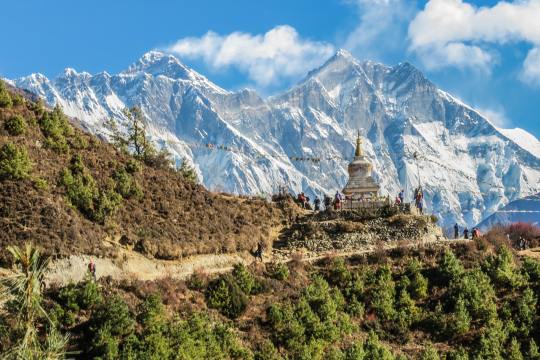
Namche Bazaar Stupa (Buddhist Temple) in Namche, Nepal
Taken by Sebastian Pena Lambarri
1 note
·
View note
Text
Everest Base Camp Trek - Conquer the Roof of the World!
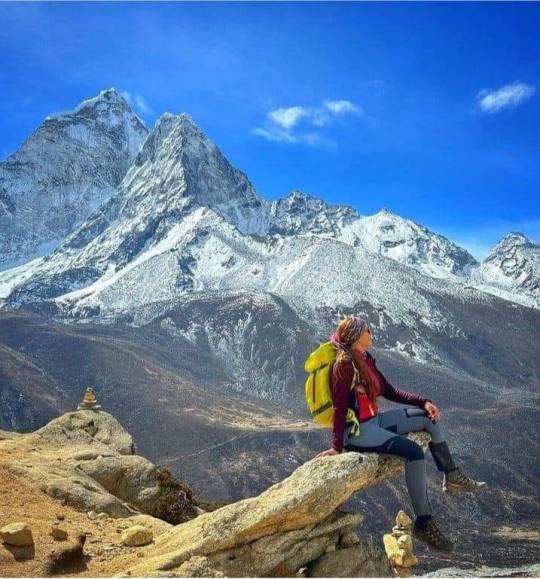
🏔️ 📅 Trip Duration: 14 days
📍 Destination: Nepal
🏞️ Trip Difficulty: Strenuous
🚍 Transport: Kathmandu - Lukla - Kathmandu
🍽️ Meals: Breakfast, Lunch & Dinner (BLD) during the trek 🏠
Accommodation: Cozy Teahouses & Lodges
👥 Group Size: Small & Personalized (Min. 1 / Max. 15)
⛰️ Max Elevation: 5,364m - Everest Base Camp
⏰ Walking Hours: 5-7 hours daily
🏁 Start/End: Kathmandu/Kathmandu
🚶♂️ Trekking Type: Local Lodge-based Tea House Trek
🌈 Best Season: February to May, September to December
🌟 TRIP HIGHLIGHTS
Trek to the base camp of the world's highest mountain, Mount Everest.
Experience the breathtaking beauty of the Khumbu region.
Witness stunning panoramic views of Everest, Lhotse, Nuptse, and more.
Explore the Sherpa culture and traditions in mountain villages.
Visit the famous Tengboche Monastery and receive blessings for a successful trek.
Travel with a small group for an intimate and personalized experience.
📋 DETAILED ITINERARY
Day 1: Arrival in Kathmandu Arrive in Kathmandu,
the bustling capital of Nepal. Meet your trekking guide and fellow adventurers. Rest and prepare for the exciting journey ahead.
Day 2: Flight to Lukla, Trek to Phakding (2,651m)
Take a thrilling flight to Lukla, the gateway to the Everest region. Embark on the trek to Phakding, passing through picturesque landscapes.
Day 3: Trek to Namche Bazaar (3,440m)
Continue the trek along the Dudh Koshi River. Climb up to Namche Bazaar, the vibrant Sherpa trading hub.
Day 4: Acclimatization Day in Namche Bazaar
Acclimatize to the increasing altitude in Namche Bazaar. Explore the town and enjoy panoramic views of Everest and surrounding peaks.
Day 5: Trek to Tengboche (3,867m)
Trek through rhododendron forests and reach the Tengboche Monastery. Experience the serene ambiance and panoramic mountain vistas.
Day 6: Trek to Dingboche (4,260m)
Descend to Debuche and cross the Imja River. Climb uphill to Dingboche, a beautiful village surrounded by mountains.
Day 7: Acclimatization Day in Dingboche
Take a day to acclimatize in Dingboche. Hike to Nagarjun Hill for breathtaking views of Ama Dablam and Lhotse.
Day 8: Trek to Lobuche (4,930m)
Trek through the moraines of the Khumbu Glacier. Reach Lobuche, a popular stop before reaching Everest Base Camp.
Day 9: Trek to Everest Base Camp (5,364m) and Gorak Shep (5,140m)
Ascend to the ultimate destination, Everest Base Camp. Witness the majestic Khumbu Icefall and the towering Everest. Descend to Gorak Shep for overnight stay.
Day 10: Hike to Kala Patthar (5,545m),
Trek to Pheriche (4,371m) Early morning hike to Kala Patthar for a stunning sunrise view over Everest. Descend to Pheriche, another beautiful Sherpa village.
Day 11: Trek to Namche Bazaar Trek back to Namche Bazaar,
enjoying the scenic landscapes. Relax and celebrate the successful completion of the trek.
Day 12: Trek to Lukla Continue the trek to Lukla,
the last leg of the journey. Reflect on the incredible adventure and bid farewell to the mountains.
Day 13: Flight to Kathmandu Fly back to Kathmandu and transfer to your hotel. Rest and celebrate the achievement of reaching Everest Base Camp.
Day 14: Departure Say goodbye to Nepal,
carrying with you unforgettable memories. Depart with a sense of accomplishment and a love for the Himalayas.
💰 COST INCLUDES
Airport transfers upon arrival and departure.
Domestic flights (Kathmandu - Lukla - Kathmandu) with airport taxes.
Accommodation in a 3-star hotel in Kathmandu with breakfast.
Tea house or lodge accommodation during the trek.
All meals (Breakfast, Lunch & Dinner) during the trek.
Licensed English-speaking trekking guide.
Porter service (1 porter for 2 trekkers) to carry your trekking gear.
Sagarmatha National Park Entry Permit.
TIMS card (Trekker's Information Management System).
All government taxes and official expenses.
🚫 COST EXCLUDES
International airfare to and from Kathmandu.
Nepal entry visa fees (available upon arrival at Kathmandu airport).
Travel and rescue insurance (mandatory).
Personal expenses such as additional meals, drinks, and snacks.
Tips for trekking staff (guide, porter, etc.).
Any extra costs incurred due to unforeseen circumstances (natural disasters, flight delays, roadblocks, etc.).
Any services not mentioned in the "Cost Includes" section.
🗨️ FOR MORE INFORMATION AND BOOKINGS, CONTACT US: Email: [email protected] WhatsApp: +977-9808262524
https://www.missionsummittreks.com/trip/everest-base-camp-trek/
🌄 Embark on a journey to conquer Everest Base Camp! 🌄
2 notes
·
View notes
Photo

Mount Everest (left) and Lhotse on a very clear day, as seen from Namche Bazaar, Nepal [OC][4215x3161]
5 notes
·
View notes
Text
Don't miss out on the enchanting experience of Everest Gokyo ri trek
Gokyo Ri Trek is a Popular trek in Nepal at Everest region. Basically, this popular trek takes 10 days trek that rakes trekkers to the picturesque Gokyo Valley and Gokyo-Ri top. This view from the top is a breathtaking mountain range including Mount Everest, Mount Lhotse, Mount Cho-you, and Mount Makalu. This all mountains are higher than 8 thousand meters. Gokyo Trek offers incredible views of some of the highest mountains in the world and is a spiritual haven for hikers. Overall, Nepal travelers feel its pristine alpine lakes and fantastic bird-watching opportunities. The trek starting point Lukla, the Gokyo Ri Trek will bring trekkers through the Sherpa Villages of Phakding, Manjo Namche bazaar, Dole, Machhermo, and Gokyo Valley. Along the way, hikers will catch glimpses of Mount Everest, Mount Lhotse, and Mount Ama-Dablam and venture over several rugged mountain passes. The passes are including the Renjola Pass, and Chola Pass which provides spectacular views of the surrounding ice-capped peaks. Alongside stunning trekking, Everest Gokyo ri trek offers a range of activities from mountaineering, to ice climbing, and helicopter tours. Gokyo is also known as home to the world’s highest glacial lake and trekkers can enjoy its stillness in the forests of blooming Rhododendrons and oak that line its bank. The people who are adventure seekers, if you are looking for an exhilarating trekking experience with exceptional views. Gokyo ri trek is highly recommended whether you are looking for the chance to explore the Sherpa culture or get an unbeatable view of the Himalayas. The Everest Gokyo Ri trek is the most-do activity.

2 notes
·
View notes